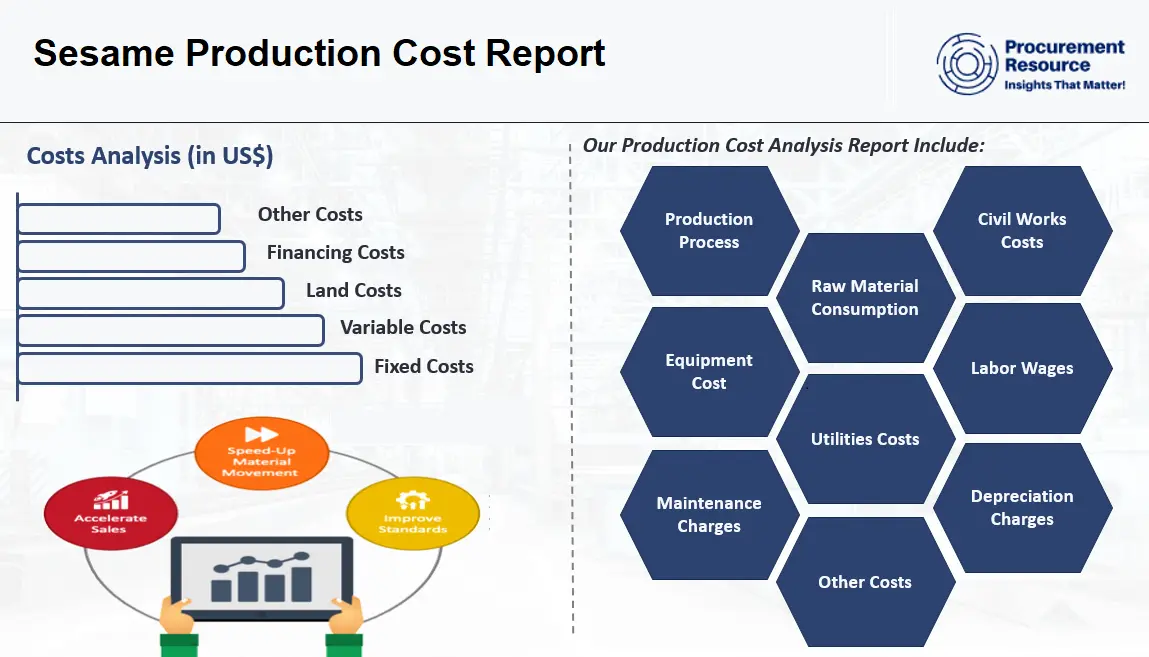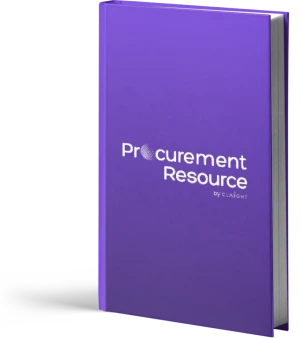Sesame Production Cost Reports
Agriculture, Farming and Commodity
The report provides a detailed analysis essential for establishing a Sesame manufacturing plant. It encompasses all critical aspects necessary for Sesame production, including the cost of Sesame production, Sesame plant cost, Sesame production costs, and the overall Sesame manufacturing plant cost. Additionally, the study covers specific expenditures associated with setting up and operating a Sesame production plant. These encompass manufacturing processes, raw material requirements, utility requirements, infrastructure needs, machinery and technology requirements, manpower requirements, packaging requirements, transportation requirements, and more.

Sesame seeds and sesame oil are highly versatile and nutritious, mainly used in culinary applications such as cooking and baking, and as important ingredients in dishes like hummus and dressings. Rich in healthy fats, protein, B vitamins, and minerals, Sesame seeds offer numerous health benefits, such as cholesterol reduction and heart health support. Additionally, Sesame oil is popular in skincare and hair care products for its moisturizing properties and potential anti-inflammatory effects. Its use in oil pulling is also noted for promoting oral health.
The market for Sesame is driven by its usage in culinary applications such as cooking and baking and as a key ingredient in dishes like hummus and dressings, which elevates its demand in the food and beverage industries. Its health benefits, such as rich antioxidant content, heart-healthy fats, and anti-inflammatory properties, amplify its market in the healthcare industry. The rising demand for natural and organic ingredients, as well as clean-label products, boosts its demand even more.
Its utilization in skincare products, hair care formulations, and nutraceuticals fuels its demand even further. Overall, industrial Sesame procurement is influenced by its application in various industries such as food, beverage, healthcare, skincare, cosmetics, nutrition, and personal care industries, the availability of its raw materials (raw sesame seeds), the rising demand for natural and organic ingredients, the demand for clean-label products, government policies, and innovation in product development.
Raw Material for Sesame Production
According to the Sesame manufacturing plant project report, the key raw materials used in the production of Sesame include raw sesame seeds.
Manufacturing Process of Sesame
The extensive Sesame production cost report consists of the following major industrial manufacturing process:
- Production via Cleaning, Dehulling, and Sorting: The manufacturing process of Sesame starts with cleaning the raw sesame seeds. The seeds are sieved, de-stoned, and all other impurities are removed. The next step is dehulling the cleaned seeds, where seeds are first soaked, followed by separating the hull, cleaning, and drying. Finally, the seeds undergo sorting, where they are fine-sorted according to their size, followed by magnetic sorting to remove magnetic debris and color sorting to produce purified Sesame seeds.
Sesame is a flowering plant in the genus Sesamum (benne). It is also referred to as Sesamum indicum. It is found in tropical, subtropical, and southern temperate areas of the world. It is one of the oldest oilseed crops. Compared to other seeds, it contains high oil content. Sesame production begins with the basic steps of producing and harvesting sesame plants, then the seeds are separated.
Sesame seeds must be harvested in a dry environment; thus, they are stored at 6% moisture or less to keep them fresh. The length of the Sesame seed is 2.5mm, and its width is 1.65 mm. The thickness of the Sesame seed is 0.94 mm. The volume of Sesame seed is 2.03 mm3, and its geometric diameter is 1.57 mm. The arithmetic diameter of a Sesame seed is 1.29 mm, and its percentage of sphericity is 62.84 %. It provides 3.5 grams of fiber. It consists of 15% saturated fat, 41% polyunsaturated fat, and 39% monounsaturated fat.
Sesame Production Cost Processes with Cost Analysis

Sesame Seeds Production via Cleaning, Dehulling and Sorting
The study offers a detailed cost analysis of Sesame Seeds Production via Cleaning, Dehulling and Sorting. In addition, the report incorporates the manufacturing process with detailed process and material flow, operating costs along with financial expenses and depreciation charges.
Details: Germany - based plant Q1 2025 From $ 2499.00 USD
Product Details
| Particulars | Details |
|---|---|
| Product Name | Sesame |
| Scope | Manufacturing Process: Process Flow, Material Flow, Material Balance Raw Material and Product Specifications: Raw Material Consumption, Product and Co-product Generation Land and Site Cost: Offsites/Civil Works, Equipment Cost, Auxiliary Equipment Costs, Contingency, Engineering and Consulting Charges, Working Capital Variable Cost: Raw Material, Utilities, Other Variable Costs Fixed Cost: Labor Requirements and Wages, Overhead Expenses, Maintenance Charges, Other Fixed Costs Financing Costs: Interest on Working Capital, Interest on Loans Other Costs: Depreciation Charges, General Sales and Admin Cost |
| Currency | US$ (Data can also be provided in the local currency) |
| Pricing and Purchase Options | Basic: US$ 2499 Premium: US$ 3499 Enterprise: US$ 4799 |
| Customization Scope | The report can be customized as per the requirement of the customer |
| Post-Sale Analysts Report | 10-12 weeks of post-purchase analyst support after report delivery for any queries from the deliverable |
| Delivery Format | PDF and Excel format through email (editable version in PPT/Word format of the report can be also provided on special request) |
How does our Sesame Production Cost Report Provide Exhaustive Data and Extensive Insights?
At Procurement Resource, we not only focus on optimizing the should cost of production for Sesame but also provide our clients with extensive intel and rigorous information on every aspect of the production process. By utilizing a comprehensive cost model, we help you break down expenses related to raw materials, labor, and technology, offering clear pathways to savings. We also assist in evaluating the capital expenditure (CAPEX) and operating expenses (OPEX), which are often measured as cost per unit of production, such as USD/MT, ensuring that your financial planning is aligned with industry benchmarks.
We offer valuable insights on the top technology providers, in-depth supplier database, and best manufacturers, helping you make informed decisions to improve efficiency. Additionally, we design the most feasible layout for your production needs, ensuring the entire process runs smoothly. By minimizing the cash cost of production, we ensure that you stay competitive while securing long-term profitability in the growing Sesame market. Partnering with Procurement Resource guarantees that every aspect of your production is cost-efficient, advanced, and tailored to your specific requirements.
Key Questions Answered in This Report
- What are the key requirements for setting up a Sesame manufacturing plant?
- How is Sesame manufactured?
- What is the process flow involved in producing Sesame?
- What are the raw material requirements and costs for producing Sesame?
- What is the total size of land required for setting up a Sesame manufacturing plant?
- What are the construction requirements for setting up a Sesame manufacturing plant?
- What are the machinery requirements for producing Sesame?
- What are the utility requirements and costs for producing Sesame?
- What are the manpower requirements for producing Sesame?
- What are the average salaries/wages of manpower working in a Sesame manufacturing plant?
- What are the packaging requirements and associated costs for Sesame?
- What are the transportation requirements and associated costs for Sesame?
- What are the capital costs for setting up a Sesame manufacturing plant?
- What are the operating costs for setting up a Sesame manufacturing plant?
- What should be the price of a Sesame?
- What will be the income and expenditures for a Sesame manufacturing plant?
Need more help?
- We can tailor the report as per your unique requirements such as desired capacity, future expansion plans, product specifications, mode of financing, plant location, etc.
- We can also provide a flexible, easy-to-use, dynamic excel-based cost-model/ dashboard where you can change the inputs to get different outputs
- Speak to our highly skilled team of analysts for insights on the recent trends and innovations, industry best practices, key success and risk factors, product pricing, margins, return on investment, industry standards and regulations, etc.
- Gain an unparalleled competitive advantage in your domain by understanding how to optimize your business operations and maximize profits
- For further assistance, please connect with our analysts
Compare & Choose the Right Report Version for You

You can easily get a quote for any Procurement Resource report. Just click here and raise a request. We will get back to you within 24 hours. Alternatively, you can also drop us an email at sales@procurementresource.com.
RIGHT PEOPLE
At Procurement Resource our analysts are selected after they are assessed thoroughly on having required qualities so that they can work effectively and productively and are able to execute projects based on the expectations shared by our clients. Our team is hence, technically exceptional, strategic, pragmatic, well experienced and competent.
RIGHT METHODOLOGY
We understand the cruciality of high-quality assessments that are important for our clients to take timely decisions and plan strategically. We have been continuously upgrading our tools and resources over the past years to become useful partners for our clientele. Our research methods are supported by most recent technology, our trusted and verified databases that are modified as per the needs help us serve our clients effectively every time and puts them ahead of their competitors.
RIGHT PRICE
Our team provides a detailed, high quality and deeply researched evaluations in competitive prices, that are unmatchable, and demonstrates our understanding of our client’s resource composition. These reports support our clientele make important procurement and supply chains choices that further helps them to place themselves ahead of their counterparts. We also offer attractive discounts or rebates on our forth coming reports.
RIGHT SUPPORT
Our vision is to enable our clients with superior quality market assessment and actionable evaluations to assist them with taking timely and right decisions. We are always ready to deliver our clients with maximum results by delivering them with customised suggestions to meet their exact needs within the specified timeline and help them understand the market dynamics in a better way.
SELECT YOUR LICENCE TYPE
- Review the available license options and choose the one that best fits your needs. Different licenses offer varying levels of access and usage rights, so make sure to pick the one that aligns with your requirements.
- If you're unsure which license is right for you, feel free to contact us for assistance.
CLICK 'BUY NOW'
- Once you've selected your desired report and license, click the ‘Buy Now’ button. This will add the report to your cart. You will be directed to the registration page where you’ll provide the necessary information to complete the purchase.
- You’ll have the chance to review your order and make adjustments, including updating your license or quantity, before proceeding to the next step.
COMPLETE REGISTRATION
- Enter your details for registration. This will include your name, email address, and any other necessary information. Creating an account allows you to easily manage your orders and gain access to future purchases or reports.
- If you already have an account with us, simply log in to streamline the process.
CHOOSE YOUR PAYMENT METHOD
- Select from a variety of secure payment options, including credit/debit cards, PayPal, or other available gateways. We ensure that all transactions are encrypted and processed securely.
- After selecting your payment method, you will be redirected to a secure checkout page to complete your transaction.
CONFIRM YOUR PURCHASE
- Once your payment is processed, you will receive an order confirmation email from sales@procurementresource.com confirming the dedicated project manger and delivery timelines.
ACCESS YOUR REPORT
- The report will be delivered to you by the project manager within the specified timeline.
- If you encounter any issues accessing your report, project manager would remain connected throughout the length of the project. The team shall assist you with post purchase analyst support for any queries or concerns from the deliverable (within the remit of the agreed scope of work).
